Exploring the development of a passive underwater breathing device that contains the respiratory pigment haemocyanin. This project extends the bounds of the body, to bring the respiratory surface (the site where oxygen passes into the body) into contact with water to augment air-breathing with water breathing.
The functional element of this wearable device is a protein called haemocyanin. Thought to be derived from an enzyme that evolved 2.5 billion years ago as a means for primordial organisms to cope with a new toxic gas that was rapidly increasing in concentration in the atmosphere. That toxin was oxygen. As a respiratory pigment, the copper in haemocyanin binds strongly enough to oxygen to gather from the environment and convey it to the tissues of many invertebrates (specifically molluscs and arthropods), but weakly enough that it can be released where it’s needed.
The wearer acquires both the characteristics and the molecules of other bimodal breathers, such as crabs, bringing humans into a relationship with those organisms. The respiratory surface works to passively bring oxygen into an air pocket close to the wearer. However, it is only by the wearer’s exhales that the oxygen transport function of haemocyanin in the mask occurs. Exhaled air creates a slightly more acidic warm environment on the inner surface. These conditions favour the unloading of oxygen from haemocyanin making it available for breathing by the wearer. Without the wearer, unloading wouldn’t occur.
Borrowing techniques from soft robotics, the form of the device is also responsive to the breathing cycle of the wearer generating breath-responsive movement. So through the interactions with a living body, the mask enters into the chain of essential life functions for that body and becomes a living device, an external organ. The material and shape of the device are designed to encourage considered presence in the environment. While the scuba diver is a voyeur, and the freediver a visitor, the wearer of Nu Ondine is exchanging molecules with the water and by vulnerability they are impelled to move with care. While currently speculative, perhaps through the empathic experience of breathing underwater more desirable futures can be fostered.
Final project Biohack Academy 2023



